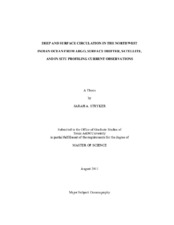| dc.description.abstract | The physical oceanography in the northwest Indian Ocean is largely controlled by the seasonal monsoon. The seasonal variability in circulation is complex. Many studies have investigated processes in the Persian (Arabian) Gulf and Arabian Sea, but little is understood about the Sea of Oman. This thesis incorporated observations from Argo floats, surface drifters and satellite imagery to study the deep and surface circulation in the northwest Indian Ocean. An assessment of four independent moorings located in the Sea of Oman and Arabian Sea, as well as a model skill comparison of the Simple Ocean Data Assimilation (SODA) model, contributed to understanding the dynamics in this region.
Spatial patterns of surface current velocity produced from surface drifter data from 1995-2009 agreed with previously known surface currents. The Somali Current, East Arabian Current, Equatorial Current, Northeast/Southwest Monsoon Current, Great Whirl and Ras al Hadd Jet were all identified. During the Southwest Monsoon, flow direction was to the east and southeast in the Arabian Sea. The Somali Current flowed northeast along the Somali Coast extending to the East Arabian Current along the Oman coast. During the Northeast Monsoon, evaporation increased over the Arabian Sea, which resulted in a salinity gradient. This imbalance caused low-salinity surface water from the northeast Indian Ocean to flow into the northwest Indian Ocean as the Northeast Monsoon Current. Current direction reversed with the change of wind direction from the Southwest Monsoon to the Northwest Monsoon. Many characteristics seen at the surface were also identified in the subsurface as deep as 1500m.
The comparison of moored observations to the Argo observations co-located in space and time showed reasonable agreement with the largest salinity difference of 0.23 and largest temperature difference of 0.78?C. The Murray Ridge mooring had a temperature correlation of 0.97 when compared to Argo observations.
Argo observations were compared with SODA model numerical output from 1992-2001, and, after Argo, were assimilated from 2002-2009. With assimilation of Argo data into the SODA model, the temperature and salinity from the model numerical output improved, with most differences between model numerical output and Argo observations falling within one standard deviation. | en |


